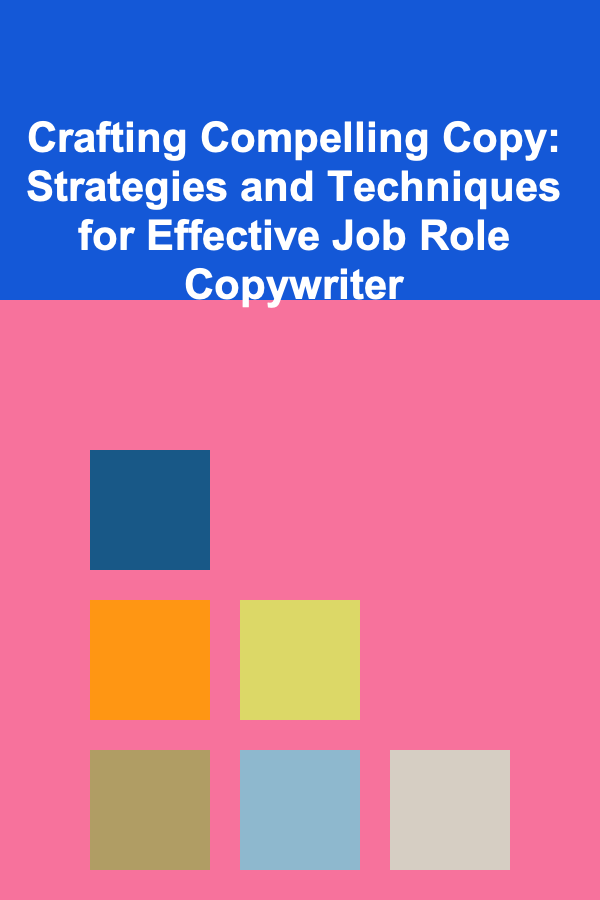
Crafting Compelling Copy: Strategies and Techniques for Effective Job Role Copywriter
ebook include PDF & Audio bundle (Micro Guide)
$12.99$5.99
Limited Time Offer! Order within the next:

Copywriting is an essential skill that businesses and brands rely on to communicate with their audience. Whether it's a catchy headline, an informative blog post, a persuasive sales page, or a social media update, the ability to craft compelling copy that resonates with the target audience is what separates successful brands from the rest. In this guide, we will delve deep into the strategies and techniques that can help you become an effective copywriter, enabling you to create content that engages, informs, and converts.
Understand Your Audience Deeply
The foundation of any great copywriting starts with an understanding of the target audience. To write compelling copy, you must know who you're speaking to, what they care about, and how they think. Without this insight, your copy risks being generic, irrelevant, or, worse, ignored.
Develop Buyer Personas
Buyer personas are detailed descriptions of your ideal customers. They are based on market research and real data about your existing customers. These personas typically include:
- Demographics: Age, gender, occupation, location, education level, income, etc.
- Psychographics: Interests, lifestyle, values, attitudes, and opinions.
- Pain Points: What challenges or problems does your audience face?
- Goals and Aspirations: What do they hope to achieve in relation to your product or service?
- Objections: What are their concerns or hesitations that could prevent them from buying?
By crafting these personas, you can ensure that your copy speaks directly to your audience's needs, wants, and emotions. It allows you to tailor your tone, style, and messaging in a way that resonates deeply with them.
Master the Art of Headlines
The headline is often the first---and sometimes only---thing your audience will read. A great headline has the power to grab attention, create curiosity, and drive the reader to continue reading the rest of the copy. Mastering this art is vital for any copywriter.
Tips for Writing Effective Headlines:
- Keep It Short and Sweet: Aim for brevity while still being clear. A good rule of thumb is to keep your headline under 10 words if possible.
- Create Curiosity: Pique the reader's curiosity by hinting at a solution or an intriguing fact. For example, "This One Habit Changed My Life" or "How We Doubled Sales in 30 Days."
- Use Power Words: Words like "ultimate," "proven," "secret," and "easy" have a psychological impact, making the reader feel like they are about to uncover something important or valuable.
- Address the Reader's Pain Points: A headline that speaks to a problem your audience is facing will grab their attention. For example, "Struggling to Stay Focused? Try These 5 Tips."
- Make It Actionable: Use verbs that encourage the reader to take action. Phrases like "Learn How," "Discover," and "Get Started" prompt the reader to move forward.
A great headline doesn't just inform the reader; it pulls them in and compels them to keep reading.
Focus on Benefits, Not Features
While it might be tempting to list the features of a product or service, this approach rarely resonates with readers. Instead, you should focus on the benefits those features provide. Benefits answer the question, "What's in it for me?"
Features vs. Benefits
- Features: "This phone has a 12 MP camera, 64 GB storage, and a 5.5-inch screen."
- Benefits: "Capture stunning photos with ease, store all your apps and memories without worrying about space, and enjoy an immersive viewing experience on a sleek, high-definition screen."
When you focus on the benefits, you are helping the reader imagine how your product or service will solve their problems or improve their lives. People don't buy products; they buy the transformation that the product can bring.
Show, Don't Tell
Instead of just telling your audience about the benefits, show them through examples, case studies, testimonials, or real-world applications. Showing helps solidify the connection between your product and the reader's needs.
Use Persuasive Techniques
Effective copywriting is all about persuasion. You are guiding your audience towards a decision---whether that's making a purchase, signing up for a newsletter, or downloading an ebook. To persuade, you need to use psychological triggers that motivate people to act.
Common Persuasive Techniques in Copywriting:
- Social Proof: People tend to trust the actions of others. Use testimonials, reviews, or case studies to demonstrate that others have had a positive experience with your product or service.
- Scarcity: The fear of missing out (FOMO) can drive urgency. Phrases like "limited-time offer" or "only a few left in stock" prompt readers to act quickly.
- Reciprocity: People feel compelled to return a favor. Offering something for free, like a free trial or downloadable resource, creates goodwill and encourages the reader to reciprocate with a purchase or sign-up.
- Authority: If you or your brand is an expert in your field, use this to your advantage. Mention certifications, awards, or partnerships that lend credibility to your message.
- Consistency: Once someone commits to a small action, they are more likely to take the next step. Start by getting the reader to agree with a small statement (e.g., "Do you want to improve your health?"), and then lead them toward the desired action.
By understanding how these psychological triggers work, you can influence your audience's decisions and increase conversion rates.
Craft a Strong Call-to-Action (CTA)
The CTA is the part of your copy that tells the reader exactly what action to take next. A strong CTA is clear, concise, and compelling. It directs the reader to the next step, whether that's making a purchase, signing up for a newsletter, or downloading a guide.
Tips for Writing Effective CTAs:
- Use Actionable Language: Verbs like "Download," "Join," "Get Started," "Claim," and "Buy" make it clear what the reader should do.
- Create Urgency: Incorporate phrases like "Limited time offer" or "Sign up today" to encourage the reader to act now.
- Highlight Value: Show the reader what they'll gain by taking action. For example, "Get your free guide now" or "Join thousands of satisfied customers."
- Make it Stand Out: Your CTA should be visually distinct from the rest of the text. Use contrasting colors, larger fonts, or buttons to ensure it draws attention.
The CTA is one of the most important elements of your copy. Without a clear CTA, your reader may not know what to do next, leading to a missed opportunity.
Optimize for Readability
No matter how compelling your copy is, it won't be effective if your audience finds it difficult to read. Copy that's dense or difficult to follow can lead to high bounce rates and low conversions. To keep your audience engaged, focus on readability.
Ways to Improve Readability:
- Use Short Paragraphs: Break your copy into short, digestible paragraphs. Long blocks of text can overwhelm the reader.
- Bullet Points and Lists: These help make the content scannable. Readers often skim content, so lists and bullet points make key information easier to digest.
- Simple, Clear Language: Avoid jargon or overly complex sentences. Use simple language to convey your message effectively.
- Subheadings: Use subheadings to break up the content and guide the reader through your message.
- Whitespace: Don't overcrowd your copy with too much text. Leave space between paragraphs and sections to give the eyes a break.
The 5th Grade Reading Level Rule
One helpful rule of thumb is to write at a 5th-grade reading level. This doesn't mean you need to oversimplify your language, but rather that your writing should be clear and accessible to a wide audience.
Edit, Edit, Edit
Great copy doesn't happen in the first draft. The best copywriters know that editing is where the magic happens. After writing your first draft, step away for a bit, then come back with fresh eyes. Look for areas where you can tighten your sentences, eliminate unnecessary words, and ensure the copy flows logically.
Editing Checklist:
- Clarity: Is the message clear and easy to understand?
- Conciseness: Can you eliminate unnecessary words or phrases without losing meaning?
- Tone: Does the tone match the target audience and brand voice?
- Spelling and Grammar: Have you checked for any spelling or grammatical errors?
- CTA: Is the call-to-action clear and compelling?
Editing is an essential step in the copywriting process. Even the best writers need to refine their work to ensure that it's as polished and impactful as possible.
Conclusion
Crafting compelling copy is an art that requires a combination of creativity, strategy, and psychological insight. By understanding your audience, focusing on benefits over features, using persuasive techniques, and optimizing readability, you can create copy that resonates with your audience and drives them to action. Whether you're writing for a blog, a sales page, or social media, these strategies will help you craft messages that capture attention, build trust, and inspire conversions. Keep honing your craft, and remember, great copywriting is always about connecting with your audience in a way that feels personal, authentic, and valuable.

How to Create a Modern Bathroom Remodel with Minimal Effort
Read More
How to Deal with Evictions Legally and Smoothly
Read More
How to Make Money Online as a Cat Behaviorist: 10 Actionable Ideas
Read More
How to Plan a Family Adventure Day at Home
Read More
How to Transform Your Bedroom with Affordable Decor
Read More
How to Use Accent Walls to Add Drama Without a High Price Tag
Read MoreOther Products

How to Create a Modern Bathroom Remodel with Minimal Effort
Read More
How to Deal with Evictions Legally and Smoothly
Read More
How to Make Money Online as a Cat Behaviorist: 10 Actionable Ideas
Read More
How to Plan a Family Adventure Day at Home
Read More
How to Transform Your Bedroom with Affordable Decor
Read More